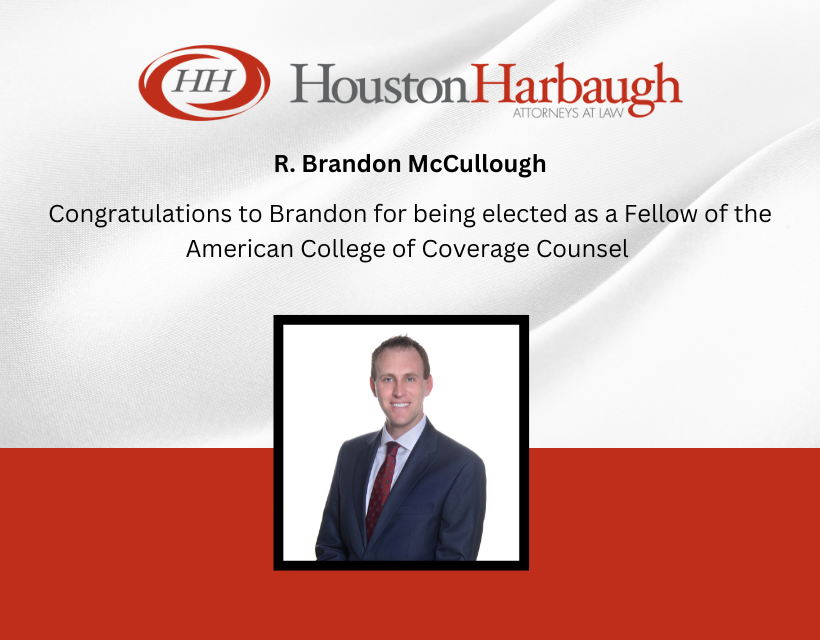PA Federal Business Decisions Volume 11, No. 2
Summary Judgment In Favor Of Defendant Health Advocate, Inc. Affirmed Where Plaintiff Failed To Establish Secondary Meaning In “Healthcare Advocates” Mark
In Flynn v. Health Advocate, Inc., 2006 U.S. App. LEXIS 4346 (3d Cir. 2006) (Opinion by Roth, J.), the Court of Appeals for the Third Circuit affirmed the United States District Court for the Eastern District of Pennsylvania’s grant of summary judgment in favor of Defendant Health Advocate, Inc. on Plaintiff Healthcare Advocates, Inc.’s claims of false designation of origin under the Lanham Act, 15 U.S.C. § 1125(a), common law trademark infringement and unfair competition.
Plaintiff Healthcare Advocates, Inc. was formed in 1996 by Plaintiff Kevin Flynn to provide advocacy services for healthcare patients. Although Healthcare Advocates began using the mark “HEALTHCARE ADVOCATES” in 1998, it was not successful in registering this mark with the United States Patent and Trademark Office. Defendant, Health Advocate, Inc. was formed in 2001, and began using the mark “HEALTH ADVOCATE.” Additionally, Health Advocate had placed the meta tag “HEALTHCARE ADVOCATES” on its website, but removed the meta tag subsequent to the filing of the district court action. In October of 2004, Healthcare Advocates filed a lawsuit against Health Advocate seeking injunctive relief and damages based on federal and common law trademark infringement and unfair competition. Healthcare Advocates alleged that Health Advocate’s use of the term “HEALTHCARE ADVOCATES” infringed upon Healthcare Advocates’ trademark and formed the basis for Healthcare Advocates’ claims. Health Advocate filed a motion for summary judgment, which the district court granted on February 8, 2005, and dismissed without prejudice Healthcare Advocates’ trademark and unfair competition claims.
The Third Circuit affirmed. To prove trademark infringement, Healthcare Advocates had to show (1) that the mark “HEALTHCARE ADVOCATES” was valid and legally protectable; (2) that it owned the mark; and (3) that Health Advocate’s use of a similar mark to identify its advocacy services was likely to create confusion concerning the origin of the goods or services. Furthermore, where a mark has not been federally registered and is not inherently distinctive, validity depends on proof of secondary meaning, which a plaintiff must establish in a mark at the time and place that a defendant begins use of the mark.
In determining whether secondary meaning exists, a court may consider (1) the extent of sales and advertising leading to buyer association; (2) length of use; (3) exclusivity of use; (4) the fact of copying; (5) customer surveys; (6) customer testimony; (7) the use of the mark in trade journals; (8) the size of the company; (9) the number of sales; (10) the number of customers; and (11) actual confusion. The district court found, and the Third Circuit agreed that Healthcare Advocates had failed to produce sufficient evidence from which a court could reasonably conclude that Healthcare Advocates had established a secondary meaning in the mark “HEALTHCARE ADVOCATES.” First, Healthcare Advocates’ sales and advertising efforts did not rise to a level which would lead to buyer association where its advertising was limited to a few local newspapers, and had no paid advertisements in trade magazines, and likewise failed to produce evidence of how many people visited its website. Second, Healthcare Advocates failed to show that it made exclusive use of the mark “HEALTHCARE ADVOCATES.” Third, Healthcare Advocates failed to provide customer testimony, surveys, or data relating to the size of its client base to sufficiently demonstrate a secondary meaning of “HEALTHCARE ADVOCATES,” notwithstanding the production of customer thank you notes and a few affidavits from former clients. Fourth, Healthcare Advocates’ small size and de minimis sales volume supported a finding that secondary meaning had not attached to the mark. Finally, the Third Circuit agreed that Healthcare Advocates’ evidence purporting to show actual confusion between the two companies was not sufficient to create a material issue of fact as to secondary meaning, where it had produced a “call log” that recorded instances in which people telephoned Healthcare Advocates when they intended to call Health Advocate, but those calls did not rise to the level of establishing secondary meaning. As Healthcare Advocates had failed to establish secondary meaning, the judgment of the district court was affirmed.
Basketball Marketing Company Calls Foul On Player For Use Of Its Trademark But Court Finds No Liability
In The Basketball Marketing Company, Inc., d/b/a And 1 v. FX Digital Media, Inc., et. al., 2006 U.S. Dist. LEXIS 9688 (E.D. Pa. 2006) (Opinion by Sanchez, J.) the district court was asked to decide whether Defendant Tim Gittens, a professional “streetball” player known as “Headache,” and the promoters of a rival street basketball tour had infringed And 1’s trademarks. A default judgment had been entered against Defendants FX Digital Media, Inc. and Columbus Woodruff. The district court found that Gitten’s contract with And 1 required him to wear clothing which branded the And 1 logo, and permitted him to play for other tours. Therefore, the district court granted summary judgment in favor of Gittens.
And 1 manufactures, sells and distributes street basketball related merchandise, including footwear, clothing and accessories which bear the And 1 name, And 1 logos and 1 trademarks. And 1 has seven trademarks registered with the PTO for the phrase “And 1,” for the logo which features the phrase “And 1” and a basketball player, and the phrase “Mix Tape” in block lettering (and as one word), although none of these trademarks is classified as for the promotion, sale, arranging or production of basketball games or tournaments. At one time, Gittens played street basketball for the And 1 Mix Tape Tour. Endorsement Agreements between Gittens and 1, dated August 1, 2001, February 1, 2002, and November 22, 2002, required Gittens to “use reasonable efforts to wear and use exclusively And 1 Products through the term of this Agreement while participating or attending all athletic activities, including but not limited to, any occasion during which he wears athletic apparel and/or poses for photographs.” Additionally, under these agreements, Gittens was permitted to participate in basketball games and related events sponsored by companies other than And 1, but was required to notify And 1 if a third party asked him to use the And 1 name or logos. The February 1, and November 22, 2002 Endorsement Agreements stated that:
Under no circumstances may [Gittens] allow a third-party, other than And 1, to use the And 1 name or logos to promote a basketball game or tournament. Should a third-party contact [Gittens] and ask him to use the And 1 name or logos for such a use, [Gittens] shall immediately notify And 1.
The November 22, 2002 Endorsement Agreement also added a clause relieving Gittens of responsibility for any third party’s use of the And 1 trademark.
Defendant, Columbus Woodruff, through his company, FX Digital Media, Inc., sponsored eight “Streetball Legends” basketball games from November 2000 through December 2002. These eight games were similar to the games on the And 1 Mix Tape Tour. Gittens played in six of the eight Streetball Legends games, and arranged for and paid basketball players for five of the eight Streetball Legends games. FX and Woodruff marketed the Streetball Legends games through flyers, all of which stated that Streetball Legends “featured players from the And 1 Mix Tapes.” Gittens had provided FX with an image of himself for t-shirts and for use on the flyers to advertise the games. Additionally, all of the players, including Gittens, had handed out flyers and advertising for certain games. Finally, while under contract with And 1, Gittens had designed an autograph card of himself wearing official And 1 gear. Gittens handed out the autograph cards both at Streetball Legends games and 1 events. Gittens did not assist Woodruff and FX in designing or printing the flyers, in applying for permits, in hiring any of the facilities or selling tickets for any of the Streetball Legends’ games.
And 1 filed a lawsuit claiming that Woodruff and FX engaged in trademark infringement and false advertisement under the Lanham Act and made a claim of contributory infringement against Gittens. And 1 also claimed unfair competition and unfair trade practices, intentional interference with existing and prospective contractual relations, and unjust enrichment against Woodruff, FX and Gittens, and breach of contract against Gittens.
To prove a Lanham Act violation, And 1 had to demonstrate: (1) it had a valid and legally protectable mark; (2) it owned the mark; and (3) the defendant’s use of the mark to identify goods or services caused a likelihood of confusion. Further, if a plaintiff claiming a Lanham Act violation can show that the mark in question is federally registered and has become incontestable, then validity, legal protectability, and ownership are proved. To be incontestable, a mark must be registered with the PTO and in continuous use for five years subsequent to registration without challenge. If not incontestable, a mark’s validity depends on proof of secondary meaning unless it is inherently distinctive. As the court pointed out, the Third Circuit follows the degree of imagination test which divides marks into four categories to determine whether a mark is protectable as a trademark: generic, descriptive, suggestive and arbitrary or fanciful.
One of And 1’s trademarks, the phrase “And 1” had been registered with the PTO for the required five years. Further, the district court found that the phrase “Mix Tape” had acquired secondary meaning and that FX’s and Woodruff’s use of the phrase “Mix Tape” caused the public to identify the Streetball Legends games with the And 1 Mix Tape Tour. Therefore, And 1 only had to show that Defendants’ use of the mark created a “likelihood of confusion” between And 1’s clothing and video products and FX’s live Streetball Legends games. Considering the default judgment that had been entered against Woodruff and FX, the only issue was whether Gittens’ use of And 1’s marks created a likelihood of confusion. The Third Circuit has identified ten factors to determine whether there is a likelihood of confusion between marks used on either competing or non-competing goods:
1. The degree of similarity between the owner’s mark and the alleged infringing mark;
2. The strength of the owner’s mark;
3. The price of the goods and other factors indicative of the care and intention expected of consumers when making a purchase;
4. The length of time the defendant has used the mark without evidence of actual confusion arising;
5. The intent of the defendant in adopting the mark;
6. The evidence of actual confusion;
7 Whether the goods, though not competing, are marketed through the same channels of trade and advertised through the same media;
8. The extent to which the targets of the parties’ sales efforts are the same;
9. The relationship of the goods in the minds of consumers be cause of the similarity of function; and
10. Other facts suggesting that the consuming public might expect the prior owner to manufacture a product in the defendants’ market or that he is likely to expand into that market.
The above test is taken from Interpace Corp. v. Lapp Inc., 721 F.2d 460 (3d Cir. 1983). The Court weighed the Lapp factors and found that Gittens’ use of the marks did not create a likelihood of confusion because Gittens was entitled to use the And 1 logo on his autograph card, on his uniform, and on a basketball he was holding in a photograph. The district court found that of the above factors, only the first, fourth, eighth and ninth factors applied to Gittens. As to the first, the court found that Gittens’ use of the And 1 marks was not a misuse. Further, Gittens did not design or create flyers, and therefore the first factor of the Lapptest did not weight in favor of a finding of a likelihood of confusion arising from Gittens’ use of And 1’s mark. With respect to the fourth factor, the district court found that Gittens used his autograph card for about a year without any evidence of actual confusion at both And 1 and Streetball Legends games to promote himself, but not the Streetball Legends games. Although the court found that because the parties targeted the same consumers, market overlap created a stronger likelihood of confusion, it held Gittens’ use of his autograph card was permissive, and not a misuse. Balancing the Lapp factors, the district court concluded that Gittens’ use of And 1’s marks did not lead to a likelihood of confusion because Gittens did not create or promote the use of the marks in the flyers, and his use of the And 1 marks on his autograph cards was required by his contract, and so could not be an infringement.
Further, the district court found that And 1 could not succeed with a false advertising claim against Gittens based on FX’s promotional flyers for the Streetball Legends’ games because the message contained in Gittens’ autograph card was not actually false. In using a picture of himself in his And 1 uniform, Gittens was conforming to the terms of his contract. Even Gittens’ assistance to Woodruff by making arrangements with the players for five of the Streetball Legends’ games did not rise to the level of substantial assistance on the part of Gittens. And 1 failed to show that Gittens was the sole source or any source of the alleged infringing materials. Therefore, the court found that joint and several liability was not appropriate.
The court further found that And 1 could not establish a cause of action under the Pennsylvania Statutory Unfair Competition Law, since And 1 had failed to establish the elements of trademark infringement under the Lanham Act. The district court rejected And 1’s assertion that Gittens had a duty under the Endorsement Agreements to inform And 1 of any third party’s usage of And 1’s trademarks. The district court turned to the plain language of the Endorsement Agreements to find that And 1’s claim had no support. Rather, under the Agreements, Gittens was only obligated to notify And 1 if any third party asked him to use the And 1 name or logos, and the November 22, 2002 Endorsement Agreement relieved Gittens of responsibility for any third party infringement. Finally, since there was no evidence of bad faith, fraud or malice on the part of Woodruff and FX, an award of attorneys’ fees for And 1 was not appropriate. The court awarded judgment in favor of Gittens and against And 1, along with attorneys’ fees and costs under Section 1117(a) of the Lanham Act.
Court Follows “First-Filed” Rule In Absence Of Extenuating Circumstances
In Oak Associates, Ltd. v. Palmer, 2006 U.S. Dist. LEXIS 4526 (E.D. Pa. 2006), plaintiff, Oak Associates, filed a declaratory judgment action against Thomas C. Palmer, requesting that the court declare that Oak Associate’s use of the term “LIVE OAK” did not infringe on Palmer’s trademark of the term “LIVE OAK.”
The suit filed by Oak Associates had been preceded by correspondence between Oak Associates and Palmer regarding the use of LIVE OAK. On March 31, 2005, Palmer’s attorneys informed Oak Associates that the use of the LIVE OAK mark constituted infringement and demanded that Oak Associates immediately cease and desist from any further use of the mark LIVE OAK. This first letter set a deadline of March 31, 2005 to meet Palmer’s demands under threat of immediate suit. A subsequent letter set a deadline of July 27, 2005, and stated that there would be no further letters.
Shortly thereafter, on August 8, 2005, Oak Associates filed suit in the Eastern District of Pennsylvania seeking a declaration that its use of LIVE OAK did not infringe on Palmer’s trademark. Palmer responded with motions to dismiss, asserting that the Eastern District of Pennsylvania lacked personal jurisdiction over him, and that venue was improper. In the alternative, Palmer sought transfer of the action to the Eastern District of Texas.
While the motions to dismiss were pending, Palmer filed a separate suit against Oak Associates in the Eastern District of Texas. The Texas complaint was based on the same set of operative facts as in Oak Associate’s complaint, and also asserted the same objections to the Pennsylvania suit as in Palmer’s motions to dismiss. In response to the Texas suit, Oak Associates filed a petition in the Eastern District of Pennsylvania requesting that the court enjoin the Texas suit based on the first-filed rule.
In deciding on the petition, the court noted that while the first-filed rule was not a “rigid or inflexible rule to be mechanically applied,” departure from the rule normally required a showing of bad faith, inequitable conduct, extraordinary circumstances, or forum shopping.
After reviewing the record, the court found that there was no evidence that Oak Associates had engaged in forum shopping, or bad faith. The court held that the mere fact that an entity in receipt of a cease and desist letter files a lawsuit does not render that lawsuit anticipatory. The court further held that the parties were not engaged in meaningful settlement negotiations such that Palmer would have been misled into believing that the dispute would be resolved amicably, and that Oak Associates had not initiated litigation during a period of time during which Palmer had agreed not to file suit.
Under these circumstances, the court held that it saw no reason to depart from the first-filed rule and granted Oak Associate’s petition, enjoining Palmer from proceeding with the litigation pending in the Eastern District of Texas.
Nexus Not Required To Raise Defense Of Copyright Misuse
In Microsoft Corp. v. Fredenburg, 2006 U.S. Dist. Lexis 11994 (W.D. Pa. 2006), Microsoft filed suit against Mark Fredenburg seeking injunctive relief and monetary damages, alleging that Fredenburg had distributed counterfeit Microsoft computer software.
Among the affirmative defenses raised by Fredenburg in response to Microsoft’s complaint were copyright misuse and unclean hands. Microsoft filed a motion seeking to have these defenses stricken as legally insufficient under Fed. R.C.P. 12(f) because Fredenburg had not alleged any nexus between Microsoft’s alleged misuse and the controversy between the parties.
In evaluating Microsoft’s motion to strike, the court cited the Third Circuit’s opinion in Video Pipeline, Inc. v. Buena Vista Home Entertainment, Inc., 342 F.3d 191, 204 (3d. Cir. 2003), in which the Court of Appeals extended the patent misuse doctrine to copyright, noting, “to defend on misuse grounds, the alleged infringer need not be subject to the purported misuse.” Based on the Third Circuit’s language in Video Pipeline, the district court denied Microsoft’s motion to strike.








